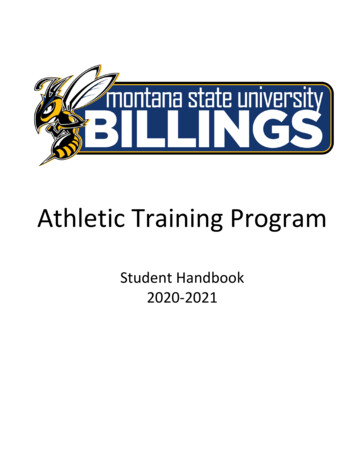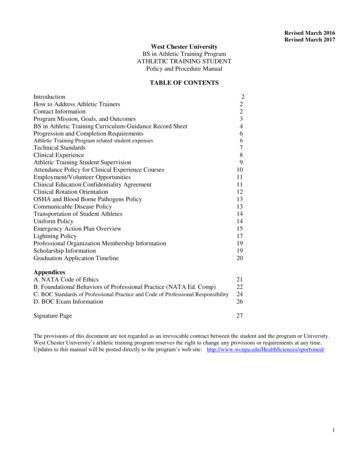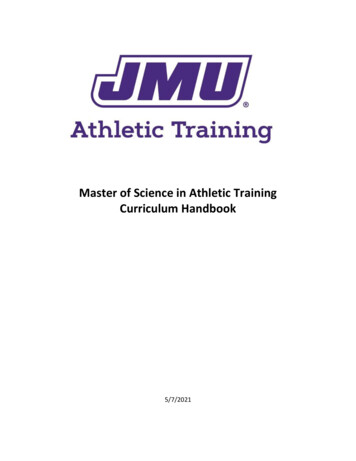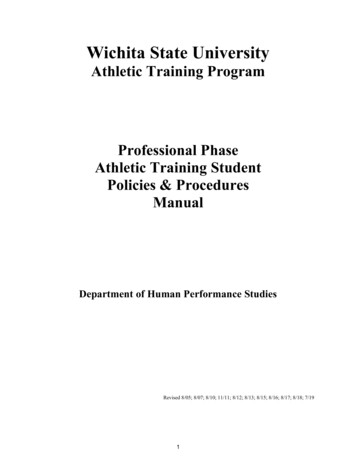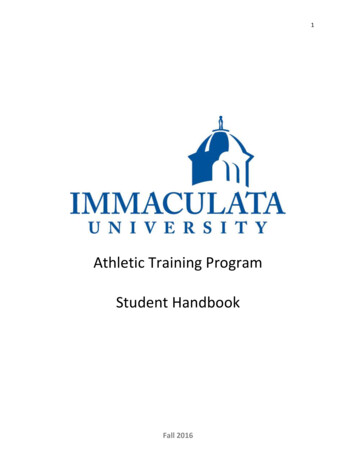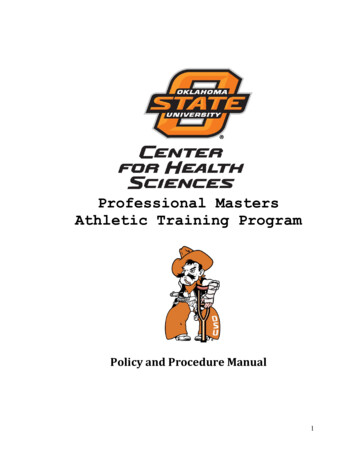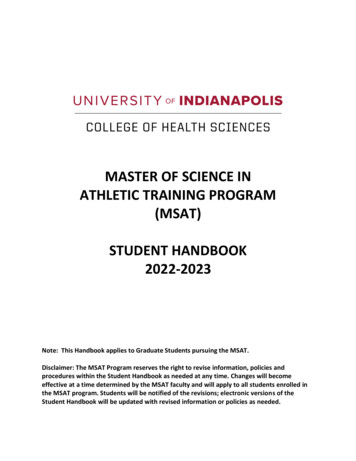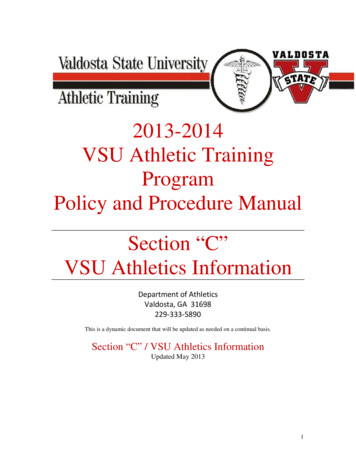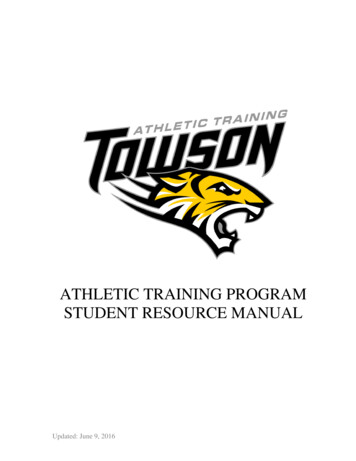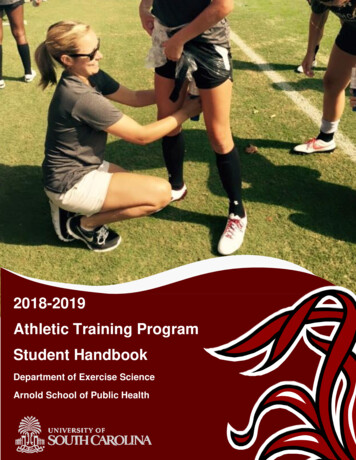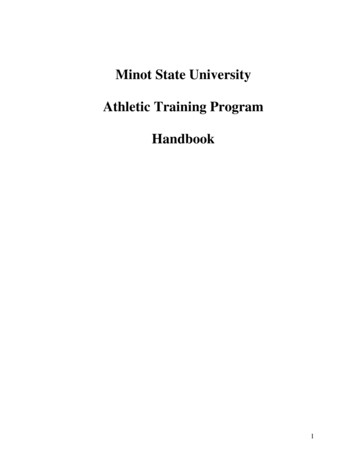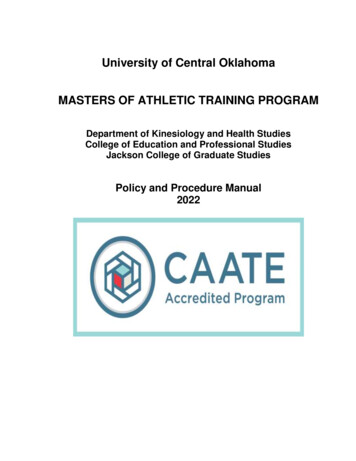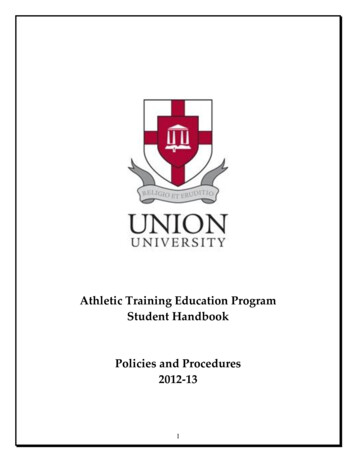
Transcription
Athletic Training Education ProgramStudent HandbookPolicies and Procedures2012-131
Union University Athletic Training Education ProgramAthletic Training Student HandbookTable of ContentsIntroduction and General InformationIntroductionAthletic Training EducationThe ATC Credential4567Union University’s Athletic Training Education ProgramAdmission RequirementsRetention PoliciesTransfer and Late Entry StudentsReadmission GuidelinesProgram Objectives81010111112Instructional Plan and Course DescriptionsATEP Curriculum/ Instructional PlanAthletic Training Course Descriptions131415Clinical EducationClinical SequenceClinical Education RequirementsClinical Experience Reflection PaperEvaluationsDisciplinary NoticesClinical Supervision and Field ExperienceThe Clinical Rotation PlanGrading the Clinical/Field ExperienceApproved Preceptors20212223232425262627ATEP Role DelineationsATEP Role Delineation OverviewATEP Faculty and StaffProgram DirectorClinical CoordinatorAssistant Professor/ Associate Athletic TrainerHead Athletic TrainerAssistant Athletic Trainer2829313132333435Policies and ProceduresOutside Employment and Athletic Training Clinical EducationSports Participation and Athletic Training Clinical EducationConduct with AthletesDating Student-AthletesOSHA Training and AwarenessExposure Control PlanATEP Student Financial ResponsibilitiesLiability InsuranceWest Tennessee Healthcare Student OrientationAdditional Fees and Fair PracticeTransportation3637373737383939393940402
Athletic Training Student Code of ConductDress Code and Personal ConductGeneral GuidelinesAcademic GuidelinesTeam GuidelinesRules when TravelingSpecial EventsRestocking and InventoryTreatmentsMedicationsRecord KeepingConfidentialityCommunicationDisciplinary ActionsStudent Conduct GuidelinesAlcohol and Substance AbuseSexual HarassmentComplaint Procedures for StudentsThe Judicial ProcessStudent RightsThe Appeal ProcessReadmission after 848Athletic Training Room GuidelinesAthletic Training Room Rules and RegulationsAthletic Training Room ProceduresInjury PreventionDaily ScheduleAreas to be CleanedSupplies, Materials and Equipment PolicyTherapeutic ModalitiesGeneral Guidelines and ProceduresCold PacksHot PacksUltrasoundElectrical Stimulation49505050505151525252535455Emergency Policies and ProceduresAED PolicyConcussion Policy and Management ProtocolEnvironmental Safety Policies and ProceduresHeat Stress / Heat Related IllnessLightning / Severe WeatherLocation of Telephones and Emergency NumbersEmergency Action Plans5657576060616566Supplemental InformationNATA Code of EthicsAthletic Training Technical StandardsTechnical Standard for AdmissionAthletic Training Student AgreementUnion University Hepatitis B Vaccination Acceptance/Declination FormProfessional Conduct and Confidentiality Agreement69707273757677AppendicesAppendix A – Disciplinary Notice FormAppendix B – Student Evaluation FormAppendix C – Student Alcohol and Drug Testing PolicyAppendix D – Heat Policies and Procedures798082893
INTRODUCTION AND GENERAL INFORMATION4
IntroductionUnion University is proud to offer the educational foundation for an exciting and rewardingcareer as a Certified Athletic Trainer. The mission of Union University’s Athletic TrainingEducation Program (ATEP) is to challenge its students to become highly effective allied healthcare professionals and leaders in the Christian community, incorporating both professional andspiritual growth in their life plans. Union incorporates into its foundation of education theequally important components of being Christ-centered, people focused, excellence driven, andfuture directed. The Union University Athletic Training Student (ATS) will study in a Christcentered atmosphere that emphasizes spiritual, technical and intellectual development so thathe/she can serve professionally in the community as a Certified Athletic Trainer and become aspiritual leader in life. The ATEP curriculum exposes athletic training students to a dynamicscholastic environment that fuses the medical sciences with Christian faith, ethics andaccountability in a variety of clinical settings that include intercollegiate athletics, high schoolathletics, orthopedic and general medicine venues, and other allied health care communities.“A Certified Athletic Trainer is a person, who, upon advice, consent and oral or writtenprescription or referrals of a physician carries out the practice of prevention, recognition,evaluation, management, disposition, treatment, or rehabilitation of athletic injuries.”Tennessee Licensure Section 63:24:101 - DefinitionsA career as a Certified Athletic Trainer (ATC) offers a great working environment with a varietyof work settings. Certified athletic trainers interact daily with athletes, coaches, doctors,therapists and other medical professionals who are involved in the dynamic field of sportsmedicine. The National Athletic Trainer’s Association (NATA) defines a certified athletictrainer as “a highly educated and skilled professional specializing in athletic health care. Incooperation with physicians, and other allied health personnel, the athletic trainer functions as anintegral member of the athletic health care team in secondary schools, colleges and universities,sports medicine clinics, professional sports programs, and other athletic health care settings.”Union University offers an outstanding entry level opportunity to those who wish to explore thepossibilities of a career in Athletic Training. This program offers a great opportunity to growprofessionally in the medical, technical, and practical knowledge of the sports medicine industry.Union University’s Athletic Training Education Program is fully accredited by the Commissionon Accreditation of Athletic Training Education (CAATE).Union University does not discriminate on the basis of race, color, national origin, religion,gender, age, veteran status, political affiliation, or disability (in compliance with theAmericans with Disabilities Act) with respect to employment or admissions. Inquiries orrequests for reasonable accommodations may be directed to the activity coordinator or theappropriate university office.5
Athletic Training EducationThe following is a brief overview of the education and credentialing process for entry-levelathletic trainers. Athletic training education programs, an academic major or the equivalent, areaccredited by the Commission on Accreditation of Athletic Training Education (CAATE) whichworks in association with the Joint Review Committee - Athletic Training (JRC-AT) and leads toa bachelor’s or master’s degree. Certification for athletic trainers is granted by the Board ofCertification, Inc. (BOC). Entry-level athletic training education uses a competency-basedapproach in both the classroom and clinical settings. Using a medical-based education model,athletic training students are educated to serve in the role of physician extenders with anemphasis on clinical reasoning skills. Educational content is based on cognitive (knowledge),psychomotor (skill), and affective (professional behaviors) competencies and clinicalproficiencies (professional, practice-oriented outcomes).Students must receive formal instruction in the following specific subject matter areas:Foundational CoursesHuman anatomyHuman physiologyExercise ics and research designStrength training and reconditioningAcute care of injury and illnessCognitive and Psychomotor DomainsRisk management and injury/illness preventionPathology of injury/illnessAssessment of injury/illnessGeneral medical conditions and disabilitiesTherapeutic modalitiesTherapeutic exercise and rehabilitationHealth care administrationWeight management and body compositionPsychosocial intervention and referralMedical ethics and legal issuesPharmacologyProfessional development and responsibilitiesClinical EducationStudents are required to participate in a minimum of two years of academic clinical education. Asegment of the clinical education experience must be directed toward a patient population havinggeneral medical ailments (e.g., cardiorespiratory, metabolic). Using an outcomes-basedapproach, students are instructed and evaluated by approved Preceptors or physicians in thevenues listed below.Union University’s Athletic Training Students will be qualified to competitively seek jobpositions in the following settings: Colleges/universitiesSecondary schoolsProfessional sportsPhysical therapy/ sports medicine clinics Industrial settings Hospitals Olympic sports6
The ATC CredentialThe ATC credential and the Board of Certification, Inc. requirements are currently recognized byforty-three states for eligibility and/or regulation of the practice of athletic trainers. The credibility ofthe BOC program and the ATC credential it awards are supported by three pillars: (1) the BOCcertification examination, (2) BOC standards of practice and disciplinary process, and (3) continuingcompetency requirements. These three areas will be addressed—BOC certification is recognized bythe National Commission for Certifying Agencies and is the only accredited certificationprogram for athletic trainers, who are allied healthcare professionals. To be certified, anindividual must demonstrate that he/she is an athletic trainer capable of performing the requiredduties without threat of harm to the public.The Board of Certification traditionally conducts annual examination development meetings duringwhich certified athletic trainers and recognized experts in the science of athletic training develop,review, and validate examination items and problems. The knowledge, skills and abilities requiredfor competent performance as an entry-level athletic trainer fall into three categories as listed below.Athletic Training Performance Categories and Practice DomainsPerformance Categories1. Understanding, applying, and analyzing2. Knowledge and decision-making3. Special performance abilitiesBoard of Certification certified athletic trainers are educated, trained and evaluated in twelvemajor practice domains:1. Risk Management and Injury Prevention2. Pathology of Injuries and Illnesses3. Orthopaedic Clinic Examination/ Diagnosis4. Medical Conditions and Disabilities5. Acute Care of Injuries and Illnesses6. Therapeutic Modalities7. Conditioning and Rehabilitative Exercise8. Pharmacology9. Psychosocial Intervention and Referral10. Nutritional Aspects of Injuries and Illnesses11. Health Care Administration12. Professional Development and ResponsibilityFor more information, visit the National Athletic Trainers’ Association at www.nata.org and theBoard of Certification, Inc. at www.bocatc.org.National Athletic Trainers’ Association Athletic Training Education Overviewwww.nata.org; info@nata.org; 2952 Stemmons Freeway, Suite 200, Dallas, Texas 75247Phone 214-637-6282, Fax 214-637-22067
UNION UNIVERSITY’SATHETIC TRAINING EDUCATION PROGRAM8
Union University’s Athletic Training Education ProgramUnion University’s Athletic Training Education Program (ATEP) is comprised of working andteaching professionals that promote excellence in workmanship, guidance and leadership. Eachindividual is responsible for representing and promoting the profession of athletic training/sportsmedicine and validating their current roles in allied health care. Each individual is also aworking member of the sport medicine team. This group of people is responsible for providinghealth care to the athletes of Union University and the Jackson community at large. This team ofworking professionals provides a teaching core for Union University’s Athletic TrainingStudents, who have the opportunity to observe, emulate and develop skills alongside mentors inboth traditional and non-traditional allied health care settings.The Union University Sports Medicine TeamDr. Chris Lewis, M.D. – ATEP Medical DirectorMr. Cliff Pawley, M.Ed., ATC, LAT – Program Director of Athletic Training EducationMs. Jennifer Farroll, M.S., ATC, LAT – ATEP Clinical CoordinatorMr. Jonathan Allen M.S., ATC, LAT – Instructor/Associate Athletic TrainerMrs. Karen T. Sinclair, M.A., ATC, LAT, PES – Head Athletic Trainer/ Adjunct InstructorMs. Brittany Haley M.S., ATC, LAT, NREMT– Assistant Athletic Trainer/ Adjunct InstructorMs. Leigh Ann Wright, M.S., ATC, LAT – Adjunct Instructor/PreceptorMrs. Tina Kautz, M.A.Ed., ATC, LAT – Adjunct thopedic/ General Medicine Referral SourcesDr. Chris Lewis, M.D. – Team Physician, The Jackson Clinic - Convenient CareDr. David Johnson, M.D. – Orthopedic Physician, West Tennessee Bone and Joint ClinicDr. Michael Cobb, M.D. – Orthopedic Physician, West Tennessee Bone and Joint ClinicDr. Harold “Trey” Antwine, M.D. – Orthopedic Physician, West Tennessee Bone and Joint ClinicDr. David Pearce, M.D. – Orthopedic Physician, West Tennessee Bone and Joint ClinicDr. Jason Hutchison, M.D. – Orthopedic Physician, West Tennessee Bone and Joint ClinicDr. Adam Smith, M.D. – Orthopedic Physician, West Tennessee Bone and Joint ClinicDr. Douglas Haltom Jr., M.D. – Orthopedic Physician, West Tennessee Bone and Joint ClinicMr. Paul Mayer, FNP – Union University Health Services9
Admission RequirementsIn order to be accepted in Union University’s Athletic Training Education Program, applicantsmust meet the criteria as described below. The program enrollment is limited by theCommission on Accreditation of Athletic Training Education (CAATE) standards; additionally,there is a self-imposed maximum of 36 positions for enrollment in this program with a maximumPreceptor-to-student ratio of no more than 4:1 for each rotation of clinical field experience.Please understand that these maximums may change based on a needs assessment of availabilityof clinical field experiences afforded by affiliated clinical sites and approved Preceptors in thevicinity of Jackson. It is advantageous for the prospective students to submit their applicationsas soon as possible. In addition to this handbook, the admission requirements for UnionUniversity’s Athletic Training Education Program are posted on the Union’s ATEP web site atwww.uu.edu/programs/atep, Union University’s Undergraduate Catalogue, and in programbrochures that are printed for public distribution. Union University makes every effort toaccommodate applicants with disabilities in accordance with the Americans with DisabilitiesAct. Technical standards are published which identify the physical and mental capabilities thatare necessary to succeed in this academic program and the athletic training profession and areenclosed in this document. The applicant’s ability to meet these standards will be evaluated aspart of the Health History and Physical Examination as required below.ATEP Admission Requirements All applicants must apply, be accepted and admitted to Union University.All applicants must complete or be currently enrolled in PEWS 240 Introduction to SportsMedicine or PEWS 218 Care and Prevention of Athletic Injuries and attain a grade of B (3.0on a 4.0 scale) or better prior to formal entry into the Athletic Training Education Program.All applicants must present a cumulative grade point average of 2.5 on a 4.0 scale.All applicants must submit to the Program Director a completed application for admission tothe Athletic Training Education Program by the deadline of April 1 for formal enrollment inthe following fall semester. Applications that are received after this date will be consideredbased on the maximum enrollment space available in the Athletic Training EducationProgram. If there is space in the ATEP, the enrollment will remain open until the maximumnumber of applicants is accepted.All applicants must submit current transcripts from all institutions that they have previouslyattended.If the number of applications outnumbers the programs spaces available, the prospectivestudents will be asked to meet with the ATEP faculty to complete a formal interview process.Retention PoliciesUnion University’s Athletic Training Education Program is a three year, six semester, sequentialeducational process. Each student must validate academic progress by (1) maintaining anaggregate grade point average of at least 2.0 on a 4.0 scale; (2) by receiving a grade of “C” orbetter in all Athletic Training (AT) courses within the instructional plan, (3) completing eachclinical course with a grade of “C” or better, and (4) remaining in good academic standing atUnion University by meeting all criteria as stated in the undergraduate catalogue. The sequentialnature of Union’s ATEP must be considered in the stages of clinical education.10
Retention in Union University’s Athletic Training Education Program All athletic training students must maintain a cumulative GPA of 2.0 on a 4.0 scale and mustbe registered as a full time student.All athletic training students must complete a physical examination from a licensed medicalpractitioner and submit a complete health history and record of all immunizations.All athletic training students must sign agreements in reference to the technical standards ofthe program, acknowledgment of the Union University Athletic Training Student Handbook,and the Hepatitis B Vaccination Election Form.All athletic training students must maintain CPR/First Aid Certification (professional rescuerwith AED training) for the duration of the program. This certification is also mandatory tocomplete the application process for the Board of Certification Examination.All athletic training students must present behavioral characteristics that are consistent withthe student expectations of Union University. Behavior that is outside of the Christianheritage of Union University will not be tolerated, nor condoned.Transfer and Late Entry StudentsEach transfer student will be evaluated on an individual basis according to the amount of collegelevel athletic training course work and clinical field experience he/she has taken from theprevious institution(s). A transfer student who has no athletic training clinical experience will berequired to follow the entrance requirements for traditional students as documented. A transferstudent with prior athletic training clinical experience from another institution must have theirclinical experience and coursework validated by the Program Director of Athletic TrainingEducation and the Director of Academic Services. A student may be admitted on a probationarybasis if space is available in the Athletic Training Education Program.Readmission to the Athletic Training Education ProgramAn athletic training student who wishes to re-enter the Athletic Training Education Programfollowing a period of inactive status (e.g., due to academic suspension, withdrawing from theuniversity, etc.) should submit a formal letter to the Program Director requesting readmission tothe program well in advance of the semester in which he/she wishes to enroll. The request forreadmission will be considered with all other applicants, and admission to the program will bebased on the same guidelines as a new applicant who is seeking enrollment. Applicants whoseek re-entry will have to contend for enrollment vacancies alongside all other applicants whoare seeking admission to the Athletic Training Education Program.11
Program ObjectivesThe objectives of Union University’s Athletic Training Education Program are clearly identifiedin the Athletic Training Educational Competencies, 4th Edition (2006), published by the NationalAthletic Trainers’ Association in accordance with the Joint Review Committee on EducationalPrograms and the Commission on Accreditation of Athletic Training Education (CAATE).These competencies serve as guidelines for the development of educational programs andlearning experiences to a student’s eligibility to challenge the Board of Certification, Inc. (BOC)certification examination. The primary objective of this and any entry-level athletic trainingeducation curriculum is to fully prepare each student to achieve success on the certificationexamination that credentials Certified Athletic Trainers, creating an opportunity for success inthe profession. The objectives embrace the following domains listed below as printed in the2005 Board of Certification Role Delineation Study (5th Edition) for professional practice ofCertified Athletic Trainers.Role Delineation for the Certified Athletic Trainer Foundational behaviors of professional practiceRisk management and injury preventionPathology of injury and illnessOrthopedic clinical examination and diagnosisMedical conditions and disabilitiesAcute care of injury and illnessesTherapeutic modalitiesConditioning and rehabilitative exercisePharmacologyPsychosocial intervention and referralNutritional aspects of injuries and illnessesHealth care administrationProfessional development and responsibilitiesIn each of these domains, specific demands are placed on the athletic training student to define,interpret, synthesize, process, and demonstrate proficiency of the given competencies in eachdomain. These domains provide the objectives and competencies that guide the athletic trainingstudent to clinical proficiency in all cognitive and psychomotor domains of athletic trainingeducation.12
INSTRUCTIONAL PLAN AND COURSE DESCRIPTIONS13
Athletic Training Education Program Curriculum/ Instructional PlanUnion University Athletic Training Education Program Instructional MapStudent Name:Student ID:Admissions ProcessUNI 195 Gateway to Christian Learning (2)Program ApplicationPEWS 100 Fitness for Health (1)Transcripts on fileCHR 111 Old Testament Survey (3)Personal InterviewENG 111 Written Composition I (3)References providedPHY 111 Principles of the Physical Sciences (4)Test scores providedPHY 213 Introduction to Physics (4)Minimum criteria for acceptance metPEWS 222 First Aid/CPR (3) **Freshman – Spring SemesterProvided upon program acceptanceMATH 111 College Algebra (3)TB Skin TestPEWS 113 Elementary Nutrition (3) **CPR/1st Aid certificationENG 112 Written Composition II (3)Criminal background checkDrug ScreeningCHR 112 New Testament Survey (3)Technical StandardsPEWS 240 Introduction to Sports Medicine (3)**Hepatitis B acceptance/declinationPEWS 170/195 Medical Terminology (2) **Physical ExaminationSophomore – Fall Semester:1st Clinical SequenceAT 265 Athletic Training Clinical I (3) **100 Clinical Hours PerformedMATH 114 Introduction to Statistics (3)BIO 221 Anatomy and Physiology I (4)ENG 201 World Literature I (3)PEWS 218 Care and Prevention of Athletic Injuries (3) **AT 170 Risk Management and Taping (1) **Sophomore – Spring Semester: 2nd Clinical SequenceAT 275 Athletic Training Clinical II (3) **100 Clinical Hours PerformedBIO 222 Anatomy and Physiology II (3)COM 112/235 Public Communication (3) orInterpersonal Communication (3)AT 360 Therapeutic Modalities (3) **AT 318 Advanced Injury Management (3) **14
Sophomore/Junior Summer TermBIO 322 Human Gross Anatomy (4)Junior – Fall Semester: 3rd Clinical SequenceAT 365 Athletic Training Clinical III (3) **125 Clinical Hours PerformedAT 361 Eval I: Upper Extremities and Cervical Spine (3) **AT 370 Eval II: Lower Extremities, Lumbar Spine (3) **PEWS 414 Kinesiology (3) **AT 350 Administration and Management Strategies (3) **Junior – Winter/January TermBIO 300 Pathophysiology (3) **Junior – Spring Semester: 4th Clinical SequenceAT 375 Athletic Training Clinical IV (3) **125 Clinical Hours PerformedAT 460 Therapeutic Exercise and Rehabilitation (3) **AT 455 General Medicine and Pharmacology (4) **PEWS 415 Physiology of Exercise (3) **PEWS 461 Exercise Testing and Prescription (3) **Senior Year – Fall Semester: 5th Clinical Sequence, Senior PracticumAT 465 Athletic Training Clinical V (3) **175 Clinical Hours PerformedPSY 213 Introduction to Psychology (3)ART 210 Arts in Western Civilization (3)HIS 101 World Civilization I (3)ENG 202 World Literature II (3)Senior Year – Spring Semester: 6th Clincial Sequence, Senior PracticumAT 475 Athletic Training Clinical VI (3)175 Clinical Hours PerformedHIS 102 World Civilization II (3)Exit evaluation completedPSY 330 Health Psychology/Psychology Elective (3)Exit Examination completed (70%)SOC 211 Principles of Sociology (3)PEWS 103 Beginning Swimming/PEWS Elective (1)Additional Coursework: Pre-professional PreparationBIO 112 Principles of Biology (4)PHY 214 Introduction to Physics II (4)BIO 211 Microbiology (4)CHEM 111 General Chemistry (4)BIO 214 Vertebrate Zoology (4)CHEM 112 Chemical Equilibrium (4)BIO 215 Botany (4)15
Athletic Training Course DescriptionsThe following is a list of course offerings in the Athletic Training (AT) major according to UnionUniversity’s 2010-2011 Undergraduate Academic Catalogue.AT 170. Taping and Risk Management (1) FPrerequisites: NoneThis course is an introduction to basic taping, preparation, wrapping and casting techniques that arecommon practice in athletic training and sports medicine. Content is based upon the 4th EditionNational Athletic Trainers’ Association Education Competencies/ Risk Management and InjuryPrevention domain.AT 265. Athletic Training Clinical I (3) F*Course restricted to students that are accepted into the Athletic Training Education ProgramPre/Corequisites: PEWS 218, 240Basic Skills. This course is a modular approach to the development of first year clinical skills forathletic training education as indicated by the NATA Athletic Training Educational Competenciesfor Athletic Training Education Programs, Fourth Edition. This course requires the student todemonstrate clinical proficiency in the cognitive and psychomotor competencies that are presentedin the prerequisite coursework. Clinical education also requires an evaluation of the student’s fieldexperience/clinical assignments.Clinical Expectations: Athletic Training Clinical I.Professional/Personal Attributes. Athletic Training Students in Union University’s ATEP areexpected to exhibit the following personal qualities: promptness, professional appearance, abilityto cooperate with peers, mentors and figures of authority, the ability to follow rules andguidelines, assertiveness and eagerness to learn, good communication skills, and a reflection ofChristian behavior. These qualities are evaluated by the Preceptor to which the student has beenassigned. This course also assesses the student’s ability to utilize basic skills in the clinicalsetting.Basic Skills. Clinical competencies that are assessed in Clinical I include knowledge of OSHAregulations and universal precautions, athletic training room rules and guidelines, policies andprocedures, emergency action plans, basic first aid, basic nutrition, basic knowledge of humananatomy and medical terminology, equipment use and maintenance, and referral resources.AT 275. Athletic Training Clinical II (3) S*Course restricted to students that are accepted into the Athletic Training Education ProgramPre/Corequisites: PEWS 218, 240Risk Management. This course is a modular approach to the development of first year clinicalskills for athletic training education as indicated by the NATA Athletic Training EducationalCompetencies for Athletic Training Education Programs, Fourth Edition. This course requires thestudent to demonstrate clinical proficiency in the cognitive and psychomotor competencies that arepresented in the prerequisite coursework. Clinical education also requires an evaluation of thestudent’s field experience/clinical assignments.16
Clinical Expectations: Athletic Training Clinical II.Professional/Personal Attributes. Athletic Training Students in Union University’s ATEP areexpected to exhibit the following personal qualities: promptness, professional appearance, abilityto cooperate with peers, mentors and figures of authority, the ability to follow rules andguidelines, assertiveness and eagerness to learn, good communication skills, and a reflection ofChristian behavior. These qualities are evaluated by the Preceptor to which the student has beenassigned. This course also assesses the student’s ability to utilize basic skills in the clinicalsetting.Basic Skills. Clinical competencies that are assessed in Clinical II include basic knowledge ofhuman anatomy and medical terminology; basic first aid; knowledge of immobilization,splinting, taping, and bandaging for specific injuries and injury prevention; and protectiveequipment utilization in collision sports.AT 318. Advanced Injury Management (3) SPrerequisite: PEWS 218Advanced preparation for triaging, treating, managing and rehabilitating chronic and acute athleticinjuries that occur in sport and physical activity. The course focuses on specific etiologies, signs,symptoms, immediate care, conservative management and surgical implications of injury anddisease processes to the orthopedic anatomy.AT 350. Administration and Management Strategies in Athletic Training (3) FPrerequisites: NoneThis course introduces the student to the administrative and management strategies that areincorporated in professional, intercollegiate, secondary school and clinical athletic trainingprofessional settings. Topics of discussion include policies and procedures, legalities in sportsmedicine, health care code, ethical codes of conduct and standards of reasonable care, andcompliance with OSHA and HIPAA in allied health care.AT 360. Therapeutic Modalities (3) SPrerequisites: PEWS 218, 240, PHY 111 or 213This course introduces the student to the various thermal, mechanical and electricalagents/modalities that are used in athletic health care and physical therapy to promote healing andrehabilitation. The class consists of lecture and lab based instruction of the use the electricalstimulation, cryotherapy, thermotherapy, hydrotherapy, ultrasound, traction, therapeutic massage,biofeedback, and compressio
Assistant Professor/ Associate Athletic Trainer 33 Head Athletic Trainer 34 . integral member of the athletic health care team in secondary schools, colleges and universities, sports medicine clinics, professional sports programs, and other athletic health care settings." . Dr. David Pearce, M.D. - Orthopedic Physician, West Tennessee .
